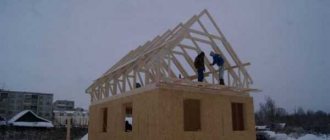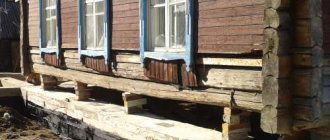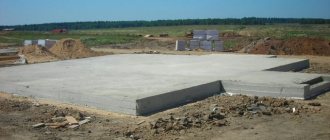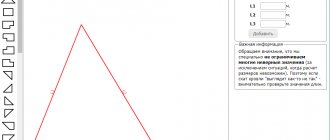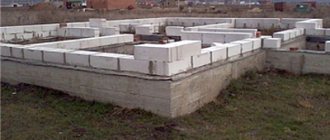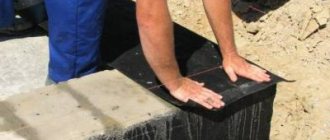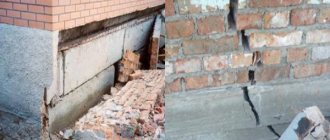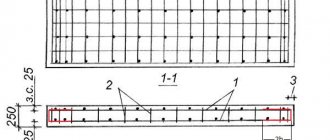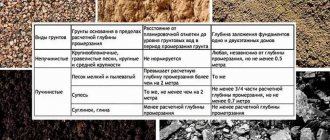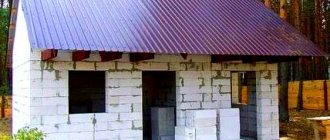The online strip foundation calculator will be useful for both developers who install it themselves and professional builders. The service allows you to determine the area of the base of the foundation strip, which can subsequently be used to calculate waterproofing, as well as the volume of concrete, reinforcement, wire for tying it, and material for formwork.
The importance of accurately calculating the strip foundation will allow you to avoid cost overruns, which amount to a quarter of the cost on the scale of the entire construction. Compliance with the construction schedule can be disrupted by forced downtime when it turns out that due to a simple error in manual calculations there is not enough material.
Shallow strip foundation
A shallow foundation saves both budget and time. And labor costs will be significantly less, since its construction does not require a deep pit. The following foundation is used for lightweight structures of small area:
- wooden houses
- aerated concrete structures or buildings constructed from aerated concrete and foam concrete blocks, the height of which does not exceed 2 floors
- monolithic buildings with permanent formwork
- small structures built of stone
The depth of the shallow foundation reaches half a meter.
How to calculate materials for a columnar foundation
When building a columnar foundation, it is necessary to correctly calculate the foundation for the house.
The online calculator processes the following data::
- number of support columns;
- diameter and height of piles;
- dimensions of the expanded part of the support located in the ground;
- grillage dimensions;
- grillage structure configuration;
- brand of concrete mixture used.
Using available information about the design features and dimensions of the pile foundation, calculations can be made manually. To do this, you need to determine the volume of one support and multiply the resulting value by the total number of piles. The volume of the grillage is calculated similarly to the tape base. By adding the volume of the supports with the volume of the grillage, we obtain the total volume of the pile structure. Now calculating the amount of concrete is not difficult.
Marking
Marking is carried out by marking on the ground both the external and internal boundaries of the future foundation. To do this, it is best to use pegs or reinforcement rods and ropes. But it will be more effective to use special devices, such as laser levels. Remember that large errors in markings will noticeably affect the appearance of the finished building.
To achieve ideal results you need:
- determine the axis of the structure being built
- use a plumb line to mark an angle, and from it, at an angle of 90 degrees, pull a rope to two more corners of the structure
- use a square to determine another angle
- check the angles, focusing on the diagonals. If the test gives positive results, pull a rope between them
- take on the internal markings, retreating from the external markings to the distance of the thickness of the future foundation
When you are finished with the markings, study the differences in the surface at the construction site and select the lowest point to measure the depth of the trench and eliminate the difference in the height of the foundation. If the building is planned to be small, then the depth of the pit can be 40 cm.
What initial data are included in the calculator for calculating the foundation for a house?
Wanting to determine the total cost and calculate the need for materials, it is important to understand how to calculate the foundation for a house.
The calculator used to perform the calculation processes a large amount of information for each type of basis:
- for a strip-type foundation base, it is necessary to take into account the dimensions of the strip, as well as its configuration;
- for a columnar base, information is processed on the number of supporting elements, their length, cross-sectional dimensions and immersion depth;
- for a structure in the form of a monolithic slab, it is necessary to take into account the thickness of the base, the area of the structure being built, as well as the design features of the frame.
Configuration and calculation results of a solid foundation
After the calculation of materials for the foundation has been performed, the calculator will be able to provide the following information :
- volume of required concrete solution;
- footage of rods (m) and total weight of reinforcement (kg);
- range of reinforcement for the frame;
- the magnitude of the load on the ground;
- the need for wood for the manufacture of formwork.
Based on the results of online calculations, you can also obtain information about the dimensions of the spatial reinforcement frame.
Installation of strip foundation formwork
The formwork is usually made of planed boards approximately 40-50 mm thick. You can use slate for this purpose.
When erecting formwork, control verticality. The recommended height of the frame above the ground is 30 cm. This is necessary to build a small base. Asbestos concrete pipes are laid in the formwork to introduce sewerage and water supply into the building.
Place a plastic film between the concrete and the formwork; this will protect the formwork from contamination.
Calculation of the foundation for a house - cost calculator
How to calculate the foundation of a house yourself
Having decided on the methodology for calculating the amount of concrete mortar and the Portland cement used for its production, you can begin to determine the overall level of costs for constructing the foundation.
Total costs include the costs of purchasing the following materials:
- medium-sized river or quarry sand;
- Portland cement of the required grade;
- medium-fraction crushed stone.
It is also necessary to take into account the purchase costs:
- steel reinforcement intended for the manufacture of the frame;
- boards, plywood panels or metal for assembling formwork;
- tying wire used to join steel rods;
- hardware used to assemble the formwork structure.
An important element of the calculation is the transportation costs associated with the delivery of the necessary materials to the construction site.
Pouring a strip foundation with concrete
Fill the formwork with concrete gradually. The thickness of the layers is 15-20 cm; to avoid voids and increase overall strength, compact the layers with a special tool - a wooden tamper or an internal vibrator.
You can order ready-mixed concrete from a factory or make it yourself using a concrete mixer. The recommended proportion of cement, sand and crushed stone is: 1:3:5.
The layers should not differ in composition. In cold weather, you should use a concrete heater and frost-resistant additives; in hot weather, water the concrete.
How to correctly determine the consumption of materials for the foundation - getting ready to perform calculations
Before starting construction activities, it is important to correctly determine the need for building materials. This will allow you to plan the amount of costs and rationally use available financial resources. Since the construction of houses is preceded by the construction of the foundation, it is necessary at the initial stage to calculate the volume of concrete mixture required for pouring the foundation. In order to perform foundation calculations, a calculator is required.
You can perform calculations in different ways:
- using a ready-made program. A foundation calculator posted on professional websites will help speed up calculations;
- performing the calculation manually. It is easy, using a regular calculator, to calculate the amount of concrete for the foundation with a high degree of accuracy.
When performing calculations, it is necessary to take into account that the amount of concrete solution is measured in cubic meters, and not in liters or tons. Taking this into account, in the process of calculations we will obtain the volume of the concrete composition, and not the weight. Before starting calculations, you should decide on the type and design of the foundation.
To do this, you need to perform a number of activities:
- carry out geodetic surveys. They help determine the level of groundwater, soil characteristics and freezing depth;
- determine the loads acting on the base. The calculator posted on the website will help you correctly and quickly calculate the foundation for a house.
Calculation of the foundation using the example of a 6x4 meter bath
Having calculated the amount of concrete for the foundation, the calculator will take into account the following data :
- type of foundation being constructed. The professional program allows you to calculate the strip base, slab base and columnar structure;
- foundation design and dimensions. The configuration and dimensions depend on the characteristics of the building, the operating loads and soil characteristics;
- the brand of concrete mortar used for pouring. It is selected depending on the level of mechanical loads;
- soil freezing level. It is determined taking into account the territorial location of the construction site.
The correctness of the calculation of the solution, as well as the consumption of materials, depends on the completeness of the entered data.
Information on the purpose of the calculator.
Online calculator for monolithic strip foundation
designed for calculating dimensions, formwork, quantity and diameter of reinforcement and volume of concrete required for the construction of this type of foundation. To determine the appropriate type of foundation, be sure to contact a specialist.
All calculations are performed in accordance with SNiP 52-01-2003 “Concrete and reinforced concrete structures”, SNiP 3.03.01-87 and GOST R 52086-2003
A strip foundation is a monolithic closed reinforced concrete strip running under each load-bearing wall of a building, thereby distributing the load along the entire length of the strip. Prevents subsidence and changes in the shape of the building due to the action of soil heaving forces. The main loads are concentrated at the corners. It is the most popular type among other foundations in the construction of private houses, as it has the best ratio of cost and necessary characteristics.
There are several types of strip foundations, such as monolithic and prefabricated, shallow and deep buried. The choice depends on the characteristics of the soil, the expected load and other parameters that must be considered in each case individually. Suitable for almost all types of buildings and can be used when constructing basements and basements.
The design of the foundation must be carried out especially carefully, since if it is deformed, this will affect the entire structure, and correcting errors is a very complex and expensive procedure.
When filling out the data, pay attention to the additional information with the Additional information sign.
The following is a complete list of calculations performed with a brief description of each item. You can also ask your question using the form on the right.
Base on stilts.
Pile foundation is an oriented group of supports that are buried in the ground. A simple and economical basis. When erecting it using the drilling method, concrete is poured into pre-drilled round holes.
In this case, the cubic capacity is the sum of two geometric figures. The first figure is the sole, in the form of a wide and low parallelepiped. The second figure is a pillar, in the form of a tall and narrow parallelepiped.
Calculation of the pile foundation.
This value is multiplied by the number of pillar supports in the base, which are located along the perimeter every 2 m.
For example, for a building 6×6 m with the number of pillar supports 20 (4 in the corners and 16 intermediate), the base of which is 0.5×0.5×0.2 m, and the pillar supports 0.3×0.3×0, 8 m, the base volume will be 20 × 0.5 × 0.5 × 0.2 = 1 m3. For pillar supports this value is 20×0.3×0.3×0.8=1.44 m3. Accordingly, the cubic capacity of the fill is 1+1.44=2.44 m3.
For an example of calculating a pile-tape foundation, look at the video:
Pile-grillage and screw foundation.
How to calculate the volume of cement for the foundation.
Scheme of a piled concrete foundation.
The total cubic capacity of such foundations is the summation of the volumes of the pillars and slabs of the grillage.
In other words, this is a combined version of calculating a strip foundation and a columnar one.
Only here the cubic capacity of the pillar cylinder is taken into account in the calculation.
Attention, if factory bored piles or screw metal structures are used, then only the tape part of the grillage is calculated, and the parameters of the pillars are not used.
They can only be used when calculating the required amount of excavation work.
Foundation reinforcement parameters
The number and dimensions of the steel bar depend on several factors:
- Type of foundation (slab, pile, strip).
- Type of soil (heaving, loose, rocks, dense foundations, etc.);
- The weight of the building itself (type of building material used, number of floors).
First of all, you need to decide what diameter of reinforcement to use for the foundation. The more complex the soil, the larger the rod size required. So, for a lightweight house on good, stable, non-heaving soil, reinforcement of 10-12 mm in diameter is used. If the house is heavy, or the soil is heaving or loose, 14-16 mm is required.
The choice of reinforcement diameter for the foundation depends on the type of soil and the mass of the building. For slab foundations, large diameters are used - the most common in private housing construction is 14 mm, for strip foundations 12 mm will be enough, and for column foundations 10 mm. But this is for normal, not very complex soils and buildings of small mass.
What kind of fittings are there?
The fittings are produced mainly from steel. It can be smooth and profiled - with a specially shaped ribbing. The ribbed one is used to distribute the load, the smooth one serves only to give the structure its shape. That is, the main emphasis should be on the quality of the ribbed rod.
Reinforcement can be smooth or ribbed
Not so long ago, plastic reinforcement for foundations appeared on the market. She is actively promoting. But few experts (sellers don’t count) advise using it. If we analyze the properties of one and another type of reinforcement, then in reality all the advantages and disadvantages look something like this:
- Conductive steel - no plastic. It cannot be said unequivocally that conductivity is a poor quality. It can be used, for example, for grounding.
- Plastic fittings are 4-5 times lighter and are produced in coils. This is a fact, but it really only affects the cost of transportation. Since there is no difference in the mass of the reinforced concrete structure, the rod weighs 50 kg or 10.
- Steel rods can be bent directly on the construction site. This cannot be done with polymer products. If necessary, bent sections will be produced at the factory according to your order. It is impossible to do this on the site yourself.
Plastic fittings - a new product on the market
- Plastic is chemically neutral and does not collapse when moisture gets into concrete. This is true. But if the rules are followed (at least 50 mm of concrete from the bars to the surface), the steel reinforcement lasts for decades and does not collapse.
- Steel begins to melt at 600o. Plastics soften at 200-300oC.
- Plastics have better strength characteristics. Not certainly in that way. They stretch more under static loads. If you make a slab foundation reinforced with plastic reinforcement, it will sag after a while: their elongation coefficient is 10-11 times greater than that of steel. It’s the same with a strip foundation: the strip can sag.
In general, it turns out the following: it is better not to use plastic reinforcement for foundations. The idea is too risky.
Calculation of reference area
When choosing a foundation, it is important to correctly determine the minimum permissible area of its support on the ground . It can be calculated using the formula S= γn · F / (γc · Ro) , where:
- γc – operating conditions coefficient;
- γn – safety factor taken equal to 1.2;
- F – full (total) load on the ground.
We recommend: How to make a strip foundation for a private house with your own hands?
The coefficient of operating conditions (working conditions) depends on the nature of the soil and structure. So, on clay soils for brick structures it is taken equal to 1.0, and for wooden ones – 1.1.
In the case of sandy soil: γc is equal to 1.2 for large and long buildings, rigid small houses; 1.3 – for any small buildings; 1.4 – for large, non-rigid houses.
Collection of ground loads (F)
Weight of the structure
The calculation is based on the load arising from the weight of all elements of the structure, including the foundation itself . Of course, it is quite difficult to accurately calculate the mass of all structural parts, and therefore average values of the specific gravity per unit surface area are taken.
Wall structures:
- frame houses with insulation with a wall thickness of 15 cm - 32-55 kg/m²;
- log and block house - 72-95 kg/m²;
- brickwork 15 cm thick – 210-260 kg/m²;
- walls made of reinforced concrete panels 15 cm thick - 305-360 kg/m².
Floors:
- attic, wooden floor, porous insulation - 75-100 kg/m²;
- the same, but with dense insulation - 140-190 kg/sq.m;
- floor covering (basement), wooden beams – 110-280 kg/m²;
- covering with concrete slabs – 500 kg/m².
Roof:
- metal roofing made of sheets – 22-30 kg/sq.m;
- roofing felt, roofing felt – 30-52 kg/sq.m;
- slate – 40-54 kg/sq.m;
- ceramic tiles – 60-75 kg/sq.m.
Calculating the weight of a structure taking into account the given specific gravities comes down to determining the area of the corresponding element and multiplying it by this indicator. In particular, to obtain the area of the walls, you need to know the perimeter of the house and the height of the walls. When calculating the roof, it is necessary to take into account the angle of the slope.
Foundation weight and snow load
The support area of the structure is determined at the level of the base, which means that the weight of the foundation must also be taken into account in the total load on the ground. The calculation method depends on its type:
- Strip foundation . First of all, the depth (Df) is determined, which should be below the freezing level. For example, at a level of 1.3 m, the normal depth is 1.7 m. Then, the perimeter of the tape (P) is determined as 2(a + b), where a and b are the length and width of the house, respectively. The width of the tape (bl) is selected taking into account the thickness of the wall. On average, it is 0.5 m. Accordingly, the volume of the strip foundation is V=P x bl x Nf . Multiplying it by the density of reinforced concrete (on average 2400 kg/m³), we obtain the estimated weight of the strip foundation.
- Columnar foundation . The calculation is carried out for each support. The weight of one column will be determined as the product of concrete density and pouring volume ( V=SxНф , where S is the area of the column). In addition, the weight of the grillage must be taken into account, which is calculated similarly to a strip foundation.
- To determine the weight of a monolithic concrete slab, its volume is calculated ( V=SxНф , where S is the area of the slab). The depth is usually about 40-50 cm.
In winter, the load on the ground can increase significantly due to the accumulation of snow on the roof. It is generally accepted that when the roof slopes at an angle of more than 60 degrees, snow does not accumulate and the snow load can be ignored.
If the roof angle is smaller, it must be taken into account. Long-term observations give the following parameters for this load:
- northern regions - 180-195 kg/m²;
- middle zone of the Russian Federation - 95-105 kg/m²;
- southern regions – up to 55 kg/m².
After determining all of the specified weight parameters, you can begin to calculate the minimum area of the sole using the above formula. The total ground load (F) is determined as the sum of the weight of the walls, floors, roof, foundation and snow load .
When calculating a column and pile foundation, the total load is divided by the number of supports, because the grillage distributes it evenly onto the supports.
How to connect
When laying reinforcing belts, the longitudinal and transverse components must be connected in some way. This is done in two ways: welding and knitting with wire.
Welding is a quick way, but not the best. The fact is that in places exposed to high temperatures, steel is more susceptible to corrosion. This is a very poor quality when laid in concrete.
The reinforcement can be connected by welding or wire
If there is one more disadvantage of a welded connection of reinforcement, there is a fairly real chance of breaking the connection during pouring or compacting the solution. It is usually pinpoint in nature and can be broken off.
The frame elements connected by welding have greater strength, but such a base is unable to respond to soil movements. And this leads to the formation of stresses in the concrete and the appearance of cracks. Therefore, we conclude: on heaving and loose soils it is better to use knitting.
Knitting of reinforcement using wire is done manually. There are some devices that make the process easier - hooks, flares, guns. But the process still takes a decent amount of time.
Read more about how to knit reinforcement for the foundation here.
Calculation of concrete requirements
Concrete pouring work should not be stopped until it is completely completed. To do this, it is important to correctly assess the need for it. The required quantity is calculated taking into account the type of foundation:
- Tape option. The calculation procedure can be seen using an example. The foundation is made for a house measuring 6x8 m. The freezing depth of the soil is 1 m, and therefore we choose a depth of 1.4 m. The width of the tape (specified by calculating the minimum support area) is 0.5 m. The volume of the foundation will be V = PxbлхНф , i.e. . (2x6x8)x1.4x0.5=67.2 m³. It is recommended to take a margin of about 8-10 percent. Finally, this foundation will require 74 m³ of concrete .
- Columnar type . If the support has a rectangular cross-section, then its area will be determined as the product of two sides. When erecting a round pillar, the well-known formula for calculating a circle is used S=3.14R2 , where R is the radius of the pillar.
- Slab foundation . The volume is determined by the formula for a regular parallelepiped, i.e. V=axbxHф , where a and b are the dimensions of the sides of the slab (m). For example, for a house 6x8 m with a depth of 0.4 m, the volume will be 19.2 m³.
We recommend: Modern technologies for do-it-yourself foundation waterproofing. What materials can be used?
It is somewhat more difficult to take into account the additional need for concrete when forming stiffeners on a slab base. They are usually made in increments of 2 m, and they must be located along the edges.
For the selected example, the number of ribs in length is 4, and in width 3. The total length of these elements will be (8x4) + (6x3) = 50 m. The most typical width and height of the ribs is 0.1 m. Therefore, the total additional volume of concrete will be 50x0.1x0.1=0.5 m³.
We recommend reading: Concrete grade and proportions for the foundation of a private house
Frame diagram
The foundation reinforcement scheme is the rules by which the frame is assembled. For each structure, its own scheme is selected, therefore, reinforcement calculations are carried out for each option separately. Based on the scheme, the following are calculated:
- quantity of reinforcement;
- her weight;
- grid parameters;
- methods of connecting rods;
- direction of the structure (horizontally or vertically);
- reinforcement section.
To carry out all these calculations, it is necessary to understand from which elements the frame is assembled. The foundation mesh consists of longitudinal and transverse rods laid at a certain pitch. They are connected to each other by welding, binding wire or couplings.
In strip foundations, the scheme is several rows of longitudinal rods installed one above the other and interconnected by transverse elements. In slab structures, one row of mesh or several can be laid.
In columnar foundations, vertical rods are installed, connected to each other by horizontal transverse elements. The cross-section of the frame can be triangular, square or round. The reinforcement in bored piles is installed vertically around the circumference.
General information on the calculation results
1. Slab perimeter
— Length of all sides of the foundation
2. Slab base area
— Equals the area of the required insulation and waterproofing between the slab and the soil.
3. Lateral surface area
— Equal to the insulation area of all sides.
4. Concrete volume
— The volume of concrete required to pour the entire foundation with the given parameters. Since the volume of concrete ordered may differ slightly from the actual one, as well as due to compaction during pouring, it is necessary to order with a 10% reserve.
5. Concrete weight
— The approximate weight of concrete based on average density is indicated.
6. Load on soil from foundation
— Distributed load over the entire support area.
7. Minimum diameter of reinforcing mesh bars
— Minimum diameter according to SNiP, taking into account the relative content of reinforcement from the cross-sectional area of the slab.
8. Minimum diameter of vertical reinforcement bars
— Minimum diameter of vertical reinforcement bars according to SNiP.
9. Grid cell size
— Average cell size of the reinforcement cage mesh.
10. Amount of reinforcement overlap
— When fastening sections of rods with overlap.
11. Total length of reinforcement
— The length of all reinforcement for tying the frame, taking into account the overlap.
12. Total weight of reinforcement
— Weight of the reinforcement cage.
13. Formwork board thickness
— Design thickness of formwork boards in accordance with GOST R 52086-2003, for given foundation parameters and at a given support spacing.
14. Number of boards for formwork
— The amount of material for formwork of a given size.
To calculate the USP, it is necessary to subtract the volume of the insulation being laid from the volume of the calculated concrete.
